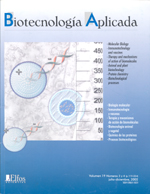
|
Biotecnologia Aplicada
Elfos Scientiae
ISSN: 0684-4551
Vol. 18, No. 2, 2001, pp. 67-75
|
 Bioline Code: ba01010
Bioline Code: ba01010
Full paper language: Spanish
Document type: Research Article
Document available free of charge
|
|
|
Biotecnologia Aplicada, Vol. 18, No. 2, 2001, pp. 67-75
| en |
Animal Models for HIV/AIDS: The Key for a Vaccine?
González, Eddy E.; Vázquez, Dania M. & Duarte, Carlos A.
Abstract
The development of a protective vaccine against HIV-1/AIDS is the only hope to control this pandemic. One of the main obstacles to achieve this goal is the lack of an appropriate animal model. The models that have been used so far can be classified into two main groups: 1) small animals and 2) primates. Regarding the former, several unsuccessful efforts including transgenesis have been carried out to achieve HIV replication in mice. The SCID mice model has been used with certain success but it is too unrelated to the natural infection. On the other hand, the infection of rabbits has been more effective since low levels of viral replication have been observed, but only when animals have been pre-treated with different substances. A rabbit transgenic for the HIV receptors CD4 and CCR5 could be permissive to productive HIV-1 infection. The model of Simian Immunodeficiency Virus (SIV) has been much more useful so far. Nevertheless, this virus displays an important genetic divergence with HIV, therefore it is not possible to extrapolate the results directly. The infection of chimpanzees with HIV-1 has also important drawbacks as the high cost, low availability and absence of clinical symptoms. Most of the attention nowadays is been given to the hybrid model or SHIV. SHIV contains the env and tat genes from HIV-1 and the rest from SIV. It can infect macaques and certain strains are even pathogenic. The main difficulty is that it is limited to the study of the effect of envelope and Tat-based vaccine candidates.
Keywords
AIDS, animal models, HIV, primates, SCID mice, SHIV
|
| |
| es |
Modelos Animales Para VIH/SIDA: ¿La Clave Para una Vacuna?
González, Eddy E.; Vázquez, Dania M. & Duarte, Carlos A.
Resumen
La obtención de una vacuna contra el VIH/SIDA es la única esperanza para controlar esta epidemia. Uno de los principales obstáculos para lograrla es la falta de un modelo animal idóneo. Hasta la fecha se ha trabajado en diferentes modelos que podemos clasificar en dos grupos: 1) animales menores y 2) primates. En el primer caso, diversos esfuerzos por lograr infección en ratones, incluida la transgénesis, han sido estériles hasta el momento. Por otra parte, el modelo del ratón SCID se ha empleado con cierto éxito, aunque está demasiado alejado de la infección natural. La infección de conejos, en cambio, ha sido más exitosa puesto que se han reportado bajos niveles de replicación en conejos tratados previamente con diferentes agentes. Un conejo transgénico para los receptores del VIH (CD4 y CCR5) podría tener éxito, al menos como modelo de infección por VIH. El modelo del Virus de la Inmunodeficiencia de Simios (VIS) en macacos ha sido mucho más útil, pero este virus también presenta importantes divergencias genéticas con el VIH. Por estas razones no es posible extrapolar directamente sus resultados al VIH. La infección de chimpancés por VIH-1 también tiene grandes limitaciones como su elevado costo, su poca disponibilidad y la ausencia de síntomas clínicos. El modelo que está recibiendo mayor atención en la actualidad es el del virus híbrido o SHIV. El SHIV posee los genes env y tat del VIH y el resto de los genes del VIS, es capaz de infectar macacos y algunas cepas son incluso patogénicas. Su limitante radica en que sólo es válido para las vacunas basadas en las proteínas de la envoltura y Tat.
Palabras-clave
modelos animales, primates, ratones SCID, SHIV, SIDA, VIH
|
| |
© Copyright 2001 Elfos Scientiae
Alternative site location: http://elfosscientiae.cigb.edu.cu/Archivo.asp?Id=6
|
|
